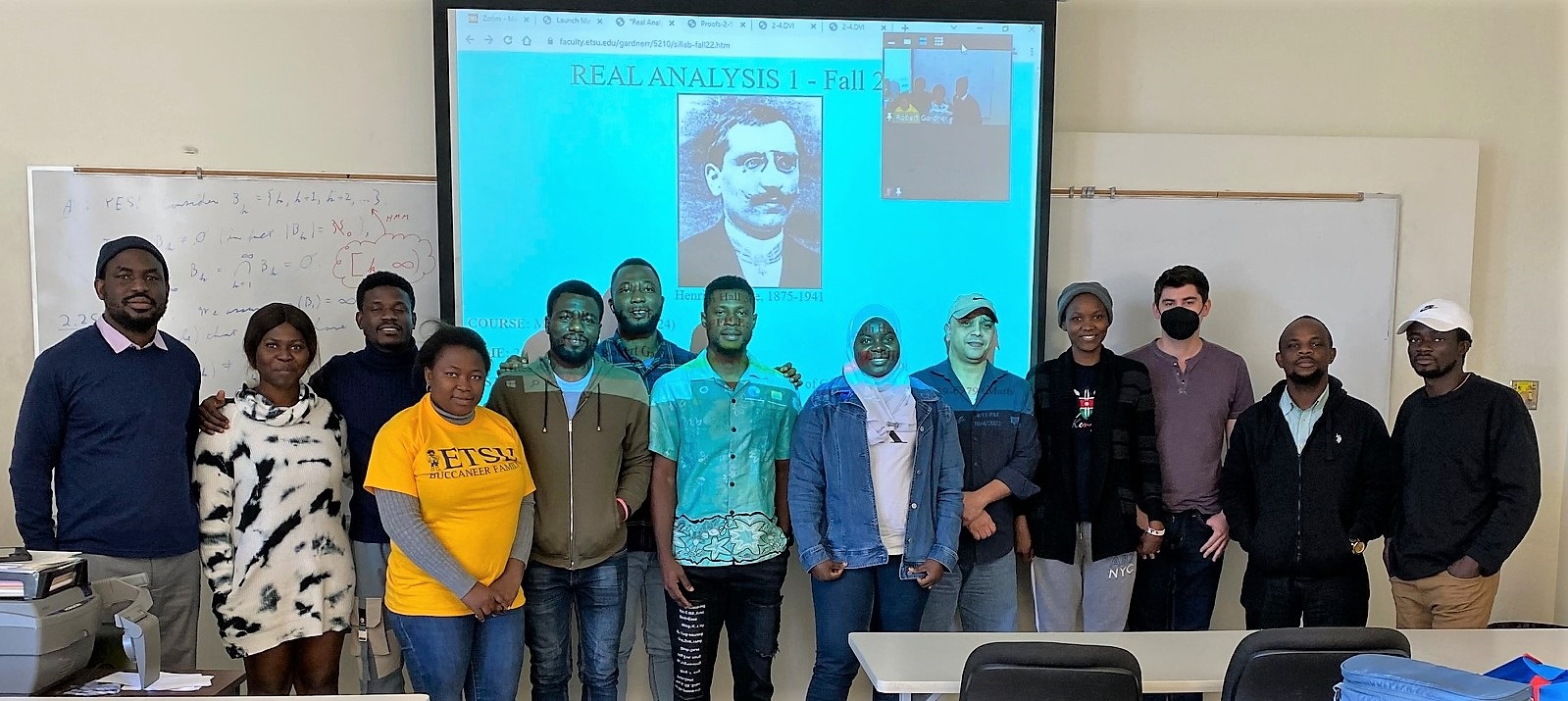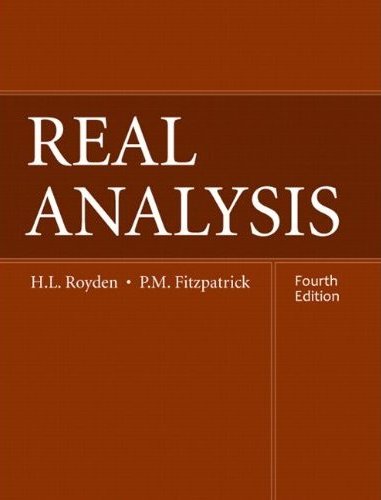
Henri Lebesgue, 1875-1941


COURSE: MATH 5210-001 (83024)
TIME: 2:55-4:15 TR, PLACE: Gilbreath Hall 304
INSTRUCTOR: Dr. Robert Gardner, OFFICE: Room 308F of Gilbreath Hall
OFFICE HOURS: By appointment (I can be available after class on TR), PHONE: 439-6979 (Math Office 439-4349)
E-MAIL: gardnerr@etsu.edu
WEBPAGE: http://faculty.etsu.edu/gardnerr/gardner.htm
TEXT: Real Analysis, Fourth Edition, by H.L. Royden and P.M. Fitzpatrick, Prentice Hall (2010).

CLASS NOTES: We will use digital notes for the component of the lecture consisting of definitions, statements of theorems, and some examples. Proofs of the vast majority of theorems, propositions, lemmas, and corollaries are available and in Beamer presentations and will be presented in class as time permits. Limited marginal notes, additional examples, and further explanations will be given using handwritten notes and a document camera. Copies of the notes are online at: http://faculty.etsu.edu/gardnerr/5210/notes1.htm. You should read the online notes to be covered in class before each class (we may not have class time to cover every little detail in the online notes). Try to understand the definitions, the examples, and the meanings of the theorems. After each class, you should read the section of the book covered in that class, paying particular attention to examples and proofs.
VIDEOS: Videos for most of the material covered in this class will be posted online and on YouTube. Links to videos are at: Real Analysis 1 online videos.
ABOUT THE COURSE: This class offers a standard introduction to the theory of functions of a real variable from the measure theoretic perspective. As commented on page 1 of the third edition of Real Analysis, we will cover "a portion of the material that every graduate student in mathematics must know." Whereas the undergraduate real analysis class presents the results of calculus from a rigorous perspective, we will introduce fundamentally new ideas which are basic extensions of the results from calculus. In particular, we will put a weight or "measure" on certain sets of real numbers. This measure will be used to define a new type of integral called the Lebesgue integral. Recall that a function is Riemann integrable if and only if it is discontinuous on a "small" set (namely, a set of measure zero). The Lebesgue integral is much more flexible and will allow us to integrate a much larger class of functions. In addition, we will have a number of "convergence theorems" related to the Lebesgue integral, which are not true in the setting of Riemann integration. The fourth edition of Real Analysis states on page x that "The general theory of measure and integration was born in the early twentieth century. It is now an indispensable ingredient in remarkably diverse areas of mathematics, including probability theory, partial differential equations, functional analysis, harmonic analysis, and dynamical systems. Indeed, it has become a unifying concept." A section of Real Analysis 2 (MATH 5220) will be offered in spring 2023, assuming there is an appropriate level of interest.
GRADING: Homework (H) to be turned in will be assigned regularly. We will have two tests (T1 and T2) and your average will be computed as follows: AVERAGE = (3H + T1 + T2)/5. Grades will be assigned based on a 10 point scale with "plus" and "minus" grades being assigned as appropriate. Based on the assignment of grad points by ETSU, the plus and minus grades should be given on a 3 point subscale. For example, a B+ corresponds to an average of 87, 88, or 89; an A- corresponds to an average of 90, 91, or 92; an A corresponds to an average of 93 to 100 (ETSU does not grant A+ grades and the highest passing grade in a graduate class is C), etc.
HOMEWORK: Homework will be assigned and collected at one week intervals. It will normally be due on Saturdays at midnight and you will be expected to submit scans in PDF of your work to D2L. YOU MUST SHOW ALL DETAILS ON THE HOMEWORK PROBLEMS!!! Justify every step and claim you make - this is how you convince me that you know what you are doing. You may find some answers online, but these rarely sufficiently justify all steps and are unacceptable as homework solutions.
ACADEMIC MISCONDUCT: While I suspect that you may work with each other on the homework problems, I expect that the work you turn in is your own and that you understand it. Some of the homework problems are fairly standard for this class, and you may find proofs online or in an online version of the solutions manual. The online proofs may not be done with the notation, definitions, and specific methods which we are developing and, therefore, are not acceptable for this class. If I get homework from two (or more) of you that is virtually identical, then neither of you will get any credit. If you copy homework solutions from an online source, then you will get no credit. These are examples of plagiarism and I will have to act on this as spelled out on ETSU's "Academic Integrity @ ETSU" webpage (last accessed 7/20/2022). To avoid this, do not copy homework and turn it in as your own!!! Even if you collaborate with someone, if you write the homework problems out in such a way that you understand all of the little steps and details, then it will be unique and your own work. If your homework is identical to one of your classmates, with the exception of using different symbols/variables and changing "hence" to "therefore," then we have a problem! If you copy a solution from a solution manual or from a website, then we have a problem! I will not hesitate to charge you with academic misconduct under these conditions.
DESIRE2LEARN: I will not rely on the Desire2Learn ("elearn") website. Instead, I will simply post all material directly on the internet. However, I will post your homework grades on D2L.
SYLLABUS ATTACHMENT: You can find an on-line version of the university's syllabus attachment (which contains general information concerning advisement, honor codes, dropping, etc.; last accessed 7/20/2022).
COVID-19 TESTING: Any student, faculty or staff member experiencing COVID-19 symptoms may contact the University Health Center (located in Nick's Hall) to schedule a test: 423-439-4225 (Monday-Friday, 8 a.m.-4:30 p.m.) and 1-888-915-7299 (after hours). COVID-19 testing is also available at the ETSU Health COVID-19 Community Collection Site (325 N State of Franklin). Appointments are required and results are available to patients within 24 hours.
COVID-19 VACCINES: ETSU runs sporadic vaccine clinics. These clinics do not require an appointment. Details are on the COVID-19 Vaccine Clinics webpage.
You can get vaccines and MANY of the local pharmacies, including the Kroger Pharmacy at 1805 West State of Franklin Road (just west of campus). All vaccines are free. More information on the vaccine is at Vaccines.Gov; you can search this site for other local vaccination locations.
COVID-19 POLICIES FOR THIS CLASS: Since ETSU has no vaccine mandate, then we can only assume that there are unvaccinated students in this class.
As such, the (fully vaccinated and boosted) instructor will likely wear a mask during class. This may result in somewhat muffled lectures, but all classnotes are online and the lectures will closely adhere to the notes. Since this is a small class, then students are encouraged to socially distance by sitting at least 6 feet apart.
In the event that on-ground classes shift to online due to a new outbreak on campus, we will adjust the grading scale given above (we will replace the in-class test grade(s) with your grade on the homework assignments).
Remember, students are "strongly encouraged to get a vaccine."
Vaccinations are the best way to avoid spreading COVID-19 and the best way to make the use of masks unnecesary.
I respectfully request and encourage you to wear a mask during face-to-face class meetings. This thing is not over.
PLANS TO DEAL WITH POTENTIAL EXPOSURE/ILLNESS: I will set up a meeting through Zoom for each class and (if all of the technology works) I will record each class. If you are not feeling well, then do not come to class! If you fear that you have been exposed and are concerned that you might be infected, then do not come to class! If you have tested positive for COVID then definitely do not come on campus for the suggested period of time! You can attend the Zoom meeting and ask questions during class (the classroom is wired for sound, so I will be able to hear you). I will follow this plan myself. If I am not feeling well or suspect that I have been exposure to COVID, then I will replace the on-ground class with the Zoom meeting which I will run from home (assuming that I am feeling well enough to lecture online).
TENTATIVE OUTLINE:
Essential Background for Real Analysis I
Real numbers, field, ordering, least upper bounds, completeness, Cauchy sequences, lim sup, lim inf, open, closed, compact, connected, Heine Borel Theorem, cardinality, countable/uncountable, Cantor's Theorem, Continuum Hypothesis.
The Riemann-Lebesgue Theorem
Riemann integral, measure zero set, oscillation, uniform convergence, convergence theorems.
Chapter 1: The Real Numbers (Section 4)
σ-algebras of sets, Borel sets, Fσ and Gδ sets.
Chapter 2: Lebesgue Measure
outer measure, measurable sets, inner approximation, Lebesgue measure, nonmeasurable set, Banach-Tarski Paradox, Cantor set and Cantor-Lebesgue Function.
Axiom of Choice: More Axiom of Choice and the Banach-Tarski Paradox.
Chapter 3: Lebesgue Measurable Functions
measurable functions, characteristic functions, approximation, Littlewood's principles, Egoroff's Theorem, Lusin's Theorem.
Chapter 4: Lebesgue Integration
Riemann integral, step functions, simple functions, Lebesgue integral of a
bounded function, Bounded Convergence Theorem, Fatou's Lemma, Monotone
Convergence Theorem, Lebesgue Dominated Convergence Theorem, general Lebesgue
integral, uniform integrability.
IMPORTANT DATES: (see the official ETSU calendar for more details; accessed 7/20/2022):
| |
|
|||
| |
||||
| |
||||
| |
2.2. Lebesgue Outer Measure |
2.6 |
||
| |
2.3. The σ-Algebra of Lebesgue Measurable Sets |
2.14 |
||
| |
||||
| |
2.4. Outer and Inner Approximation of Lebesgue Measurable Sets |
2.17, 2.18 |
||
| |
||||
| |
||||
| |
||||
| |
||||
| |
||||
| |
||||
Return to Bob Gardner's home page
Last updated: November 30, 2022